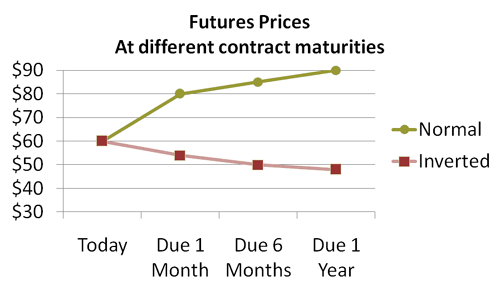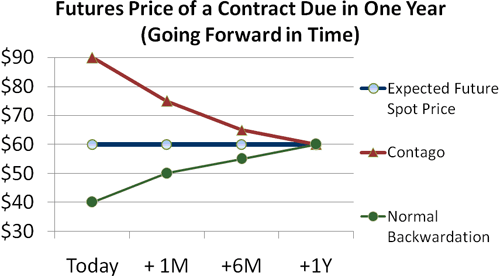We're going to be hearing these terms a lot in the next few weeks.
Even very sharp people can have trouble integrating the concepts into their investing worldview so that the relationships are seen automatically and you can use your brain for other, important, things.
First up, the framework:
contango: CURRENT spot price < future price
backwardation: CURRENT spot price > future price
normal contango: EXPECTED spot price < future price
normal backwardation: EXPECTED spot price > future price
That's it.
If a person can get the picture at a subconscious level they have a chance at making it in commodities.
I dumped this stuff on the reader in February's "
The Trouble With Gold (GLD)" without much explanation (I'm a lousy teacher):
....So there you have it. Anyone messing with commodities must have this
stuff incorporated into their worldview the way a bond trader uses the
interest rate/bond price see-saw without even thinking about it.
Now, you can either re-read "Gold, the rate of reburying trade" or you can read "The Working Curve and Commodity Storage under Backwardation":
Abstract
There remains controversy over whether the
empirical curve relating intertemporal commodity price spreads and
stocks, originally
drawn by Holbrook Working in 1933 (i.e., the
Working curve), is a valid stylized fact in commodity markets. The core
of the
controversy is the portion of the curve
representing commodity stocks under backwardation. In this article we
analyze the
original data used by Working, plus more
disaggregated numbers. We find that the Working curve is indeed valid.
The diversity
of stockholders and different stockholding motives
most likely explain the empirical Working curve relationship.
But if you're going to do that you should probably read Keynes' "theory
of normal backwardation" (not to be confused with backwardation).
...just read Izzy.
to understand what Goldman was doing to their "Long-only index
investors" with the GSCI swaps (it's no accident that the GSCI is so
weighted to oil) or...
...just read Izzy.
Front futures $1,676.20.
For the visually attuned here are the relevant charts and a pretty good discussion
at Investopedia:
Contango Vs. Normal Backwardation
...Normal and Inverted: Snapshot in TimeA contango market is often confused with a normal futures curve; and a normal backwardation market is confused with an inverted futures curve.
Let's
start by getting an understanding of the difference between the two.
Start with a static picture of a futures curve. A static picture of the
futures curve plots futures prices (y-axis) against contract maturities (i.e., terms to maturity). This is analogous to a plot of the term structure
of interest rates: we are looking at prices for many different
maturities as they extend into the horizon. The chart below plots a normal market in greenand an inverted market in red:
 |
| Copyright ã 2007 Investopedia.com |
| Figure 1 |
The plot above is a hypothetical plot
for crude oil futures. There is no reason to expect a flat line. The
current price is called the spot price. In the chart above, the spot price is $60. In the normal (green line) market, a one-year futures contract is priced at $90. Therefore, if you take a long position
in the one-year contract, you promise to purchase one contract for $90
in one year. Our long position is not an option in the future - it is an
obligation in the future.
Supply/Demand Determines the Shape
The red line in Figure 1, on the other hand, depicts an inverted market.
In an inverted market, the futures price for faraway deliveries is less
than the spot price. Why would a futures curve invert? Because, in the
case of a physical asset, there may be some benefit to owning the asset
(called the convenience yield) or, in the case of a financial asset, ownership may confer a dividend to the owner.
A few fundamental factors (i.e., the cost to carry a physical asset or
finance a financial asset) inform supply/demand for the commodity, which
ultimately determines the shape of the futures curve. If we really want
to be precise, we could say that fundamentals like storage cost,
financing cost (cost to carry)
and convenience yield inform supply and demand. Supply meets demand
where market participants are willing to agree about the expected future
spot price. Their consensus view sets the futures price. And that's why
a futures price changes over time: market participants update their
views about the future expected spot price.
The traditional crude oil futures curve, for example, is typically
humped: it is normal in the short-term but gives way to an inverted
market for longer maturities.
Contango and Normal Backwardation: Patterns over Time
We
have established that a futures market is normal if futures prices are
higher at longer maturities and inverted if futures prices are lower at
distant maturities.
This is where the concept gets a little tricky, so we'll start with two key ideas:
- As we approach contract maturity (we might be long or short the futures contract, it doesn't matter), the futures price must converge toward the spot price. The difference is called the basis. That's because, on the maturity date, the futures price must equal the spot price. If they don't converge on maturity, anybody could make free money with an easy arbitrage.
- The most rational futures price is the expected future spot price.
For example, if you and your counterparty both could foresee that the
spot price in crude oil would be $80 in one year, you would rationally
settle on an $80 futures price. Anything above or below would represent a
loss for one of you!
Now we can define contango and normal backwardation.
The difference is that normal/inverted refers to the shape of the curve
as we take a snapshot in time. Contango and normal backwardation refer
to the pattern of prices over time. Specifically, is the price of our
contract rising or falling?
Suppose we entered into a December 2012 futures contract, today, for
$100. Now go forward one month. The same December 2012 future contract
could still be $100, but it might also have increased to $110 (this
implies normal backwardation) or it might have decreased to $90 (implies
contango). The definitions are as follows:
- Contango
is when the futures price is above the expected future spot price.
Because the futures price must converge on the expected future spot
price, contango implies that futures prices are falling over time as new
information brings them into line with the expected future spot price.
- Normal backwardation
is when the futures price is below the expected future spot price. This
is desirable for speculators who are "net long" in their positions:
they want the futures price to increase. So, normal backwardation is
when the futures prices are increasing.
Consider a futures contract that we purchase today, due in exactly one
year. Assume the expected future spot price is $60 (see the blue flat line in Figure 2 below). If today's cost for the one-year futures contract is $90 (the red line), the futures price is above the expected future spot price.
This is a contango scenario. Unless the expected future spot price
changes, the contract price must drop. If we go forward in time one
month, note that we will be referring to an 11-month contract; in six
months, it will be a six-month contract.
 |
| Copyright ã 2007 Investopedia.com |
| Figure 2 |
Sorting out the Confusion
Clearly, it is more precise to say that in contango, futures prices for a given maturity date
are falling. In normal backwardation, futures are rising. This is not
exactly the same as the shape of the futures curve because futures
prices are constantly adjusting to consensus expectations about the
expected future spot price.
Finally, consider a distinction that
seems to exist only to confuse. Normal backwardation is not quite the
same as backwardation. (For more insight on this, pick up a copy of
"Futures, Options And Swaps" (2007) by Robert Kolb and James Overdahl).
Backwardation is the same as inverted when futures prices are lower than
spot prices. But in many cases, it's better to stick with inverted and
drop backwardation altogether....
If a person can get the picture at a subconscious level they have a chance at making it in commodities.
I dumped this stuff on the reader in February's "The Trouble With Gold (GLD)" without much explanation (I'm a lousy teacher):
For the visually attuned here are the relevant charts and a pretty good discussion at Investopedia:
Contango Vs. Normal Backwardation